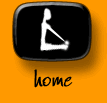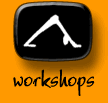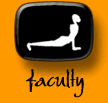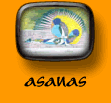

 |
 |
 |
 |
 |
 |
|
DOWNDOG | EAGLE | COBRA | HERO | HALF MOON | CORPSE | GATE
TRIANGLE | PEACOCK | LOCUST | COBBLER | SHOULDER STAND HEADSTAND | BRIDGE | CAMEL | COW FACE | UP BOW | INVERTED STAFF SEATED WIDE ANGLE | HEAD TO KNEE | TORTOISE | DANCER NOOSE  |
| Pashaasana ~ Noose Pose The benefits of putting yourself in this noose are many. Like other twists, pashasana wrings out the body, releasing tension and thereby increasing circulation and beneficial energy flow. When the compressed area is released, blood rushes back in, cleansing and nourishing tissues and organs. So you feel refreshed, relaxed and more alive. Noose pose also stretches the Achilles tendon and back of the calves, and makes the ankles more flexible. It frees the shoulders, opens the chest, tones the spine and abdominal organs, rejuvenates tired legs, and improves digestion. And if that's not enough reason to do this pose, it also reduces fat around the abdomen and waist. So come on baby, let's do the twist!
Practice Tips If you have the required flexibility, the pose itself is relatively simple. You squat down with feet and legs together, with your torso against your thighs and your pelvis close to the heels (but not on the floor). Then twist from your belly to the right, extend your left arm, and bring the upper arm to the outside of your right knee, with the armpit into the thigh. Turning the palm down, bend the elbow and wrap the forearm down around the right shin. Extend your right arm up and sweep it around in back so you can grab the right wrist with your left hand. (It helps to look to the right as you do this to allow the right shoulder to open back more. If you can't grab the wrist, hook the fingers or use a strap to close the gap.) You're now in the noose. To deepen the pose, use the arm against the knee as a lever to twist more to the right, turning your gaze (drishti) infinitely to the right. As you do, pull your shoulder blades towards each other and down the back, keep the outer hips firm (mula bandha helps this), and keep pressing the heels more into the floor as you descend the sitting bones toward them. On the inhale, lift the sternum and lengthen out through the top of you head. On the exhale, twist a little more, leading with the left ribs. After five deep breaths or so, untwist and do the other side. But if you're like most of us, you won't have all the required flexibility, and Pashasana will be a real struggle. So you might want to approach in stages, using props to compensate for stiffness in ankles, hips or shoulders. For starters, you might want to just go into a shallow squat, with your hips a foot or more above the floor, and, twisting right, take your left arm to the outside of your right knee and place your fingertips or palm on the floor to the outside of the right foot. Use your arm as a lever to deepen the twist, perhaps reaching the right arm up and around to catch the left hip or inner thigh for more leverage. Keep looping the shoulders open, lengthening the spine and descending the sitting bones toward the heels (try to get them at least parallel to the floor) as you do this prep. If you're trying to go further in the pose but your heels don't come to the floor when you squat fully (back of thighs into your calves), or they barely touch and you fall down to sit as soon as you try to twist, place a folded blanket, a block or a rolled mat under your heels for support. Or let the heels stay up and keep both hands on the floor as you twist to the right, perhaps again stretching the right arm up and back to catch the left hip or inner thigh as a lever point to open the shoulders and deepen the twist. If the heels are grounded on the floor or some support but you can't wrap the arms and clasp the hands, you can take the left elbow to the outside of the right knee and press the palms together to deepen the twist. Or try taking the left arm between the legs to the inside of the left knee and wrap and clasp in what you could call 'half noose' pose. You can also work with your right hip near a wall so you can twist to the right and place the hands on the wall with your left elbow against the right thigh, and use the elbow and wall as fulcrums to lever yourself more into the twist. Then, using your right hand on the wall for support, you can begin to wrap the left arm down around your right shin. And if you rest your buttocks on a block to help balance (either near a wall or not), you might be able to swing the right arm behind and clasp. Of course, having a teacher or practice partner to help you with the pose can enable you to go much farther into it than you might by yourself. Even though I still can't do Pashasana full out, it's one of my favorite twists, because it works the body in so many ways at once to release tension, stimulate energy flow, open tight areas and rejuvenate you both physically and mentally. The Noose is definitely a pose to hang out in often. For a closer look at ways to prep for Pashsana, see Maty Ezraty's excellent article and photos on this pose in the September/October 2002 issue of Yoga Journal. Text by Tim
Noworyta |
||
|
E-mail: info@yogamind.com | Return Home :: mindfully designed by braddon.com :: |